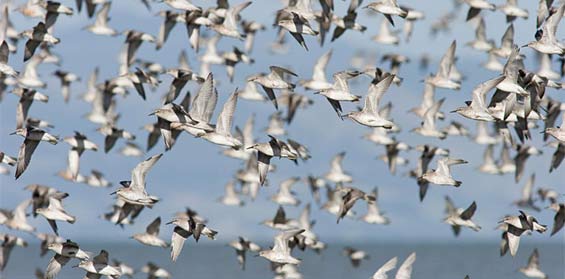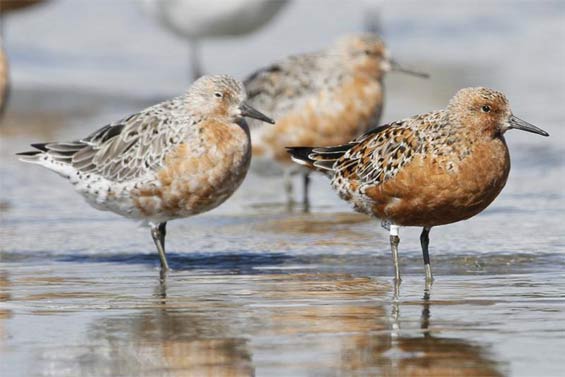By Bruce McKinlay | Technical Advisor, Ecosystems and Species
Department of Conservation – New Zealand
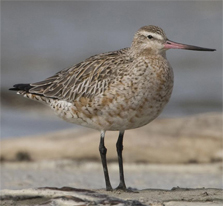
A male Godwit showing how fat they are before migrating to China © Bruce McKinlay Department of Conservation – New Zealand
Bar-tailed Godwits spend the Austral summer in New Zealand and Australia and each year they complete an epic journey from the Southern Hemisphere to the Yellow Sea, then Alaska, and then back again. Every September about 80,000 of them fly back to New Zealand.
A recent report revealed that a number of Godwits have been recaptured more than 18 years after they were banded – this is quite an incredible feat!
The implication of travelling each year from the Southern Hemisphere to the Yellow Sea, then to Alaska for breeding and then back (over 20 times!) is mind boggling stuff.
Especially for a bird that weights a maximum of 400g for males, and up to 600g for females.
Even more impressive is the report of a Red Knot, which was last seen in 2012, more than 22 years after it was banded.
That’s a 100 g bird travelling from New Zealand to Siberia each year for 22 years. That is a serious amount of Airpoints dollars (or in this case polycheate worms).
Enroute to the Arctic: habitat changes in the Yellow Sea
Although these recent findings are exciting, both the Bar-tailed Godwit and the Red Knot are declining.
The best science we have shows that declines in both of these as well as other shorebird species is due to habitat change in the Yellow Sea region. This is where they stop over on their migrations to and from the Arctic breeding grounds to refuel and gather food.
This science has been gathered as a result of the dedication of wader researchers both here and in Australia. In New Zealand this work has been led by P?korokoro Miranda Naturalists Trust and Birds New Zealand (OSNZ). These groups undertake bird banding and counts and advocate for the birds and their habitat needs.
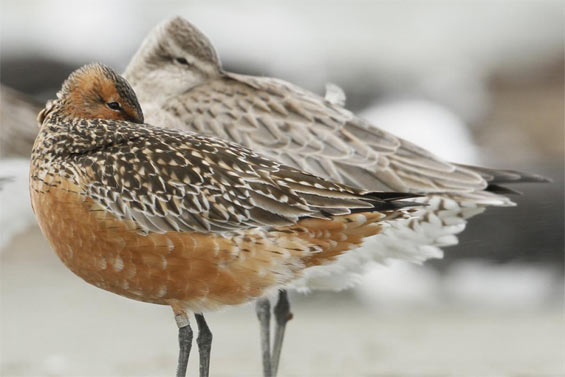
Bar-tailed Godwits at rest on a roost in New Zealand © Bruce McKinlay Department of Conservation – New Zealand
East Asian-Australasian Flyway
These birds are all part of the East Asian-Australasian Flyway (EAAF), which is one of nine flyways that circle our world. The EAAF extends from Awarua Bay in the south of New Zealand to the North Slope in Alaska, and from as far west as Myanmar to Alaska in the east. It is one of the most significant biological features of planet Earth and it is in trouble.
Reclamation, pollution, and hunting are causing declines of 5-9% per year in a number of bird species. The most important driver of change is reclamation in the Yellow Sea region, where remote sensing has shown a 35% loss of intertidal habitat area across six key areas since the early 1980s.
Helping our migratory waterbirds
Protection of the New Zealand populations of Bar-tailed Godwits and Red Knots requires engagement with partners as far away as Russia and USA, but in particular China and DPR Korea.
New Zealand is now a member of the East Asian-Australasian Flyway Partnership (EAAFP). This is the key body seeking to guide governmental and non-governmental action to ensure that declines of migratory waterbird populations are reduced. They want to ensure that key habitats along the flyway are protected, and where possible enhanced, for migratory birds.
A key partner in this work is the P?korokoro Miranda Naturalists Trust who have a long and respected history as a passionate advocate for shorebirds. They have also had a ‘sister reserve’ partnership with the Yalu Jiang National Nature Reserve in north east China for the last 10 years.
Working together with China and DPR Korea
Along with colleagues from P?korokoro-Miranda Naturalists Trust (Adrian Riegen, Estella Lee and Keith Woodley), Carol West (Director of Terrestrial Ecosystems at DOC) and I had a successful three weeks in China and DPR Korea.
We celebrated ten years of a sister-site relationship between the Yalu Jiang National Nature Reserve and Miranda. We also engaged with both Governments about how to work better into the future to protect shorebird habitat.
As part of the Dandong International Bird Watching Festival a report on the results of ten years of monitoring migratory shore birds was released to partners in China. The launch of the report was a successful event supported by the New Zealand Ambassador to China, Carl Worker. The report will hopefully raise the profile of this work at all levels in the Chinese Government, and provide the basis for further work and exchange of ideas and cooperation.
We also spent time in Beijing where we met with officials from a range of ministries, and academics to discuss the issues in the EAAFP and how to work in the future to protect shorebirds and their habitats.
Two days in DPR Korea saw us meeting with the Nature Conservation Union of Korea (NCUK) where an agreement to work bilaterally was signed between Miranda and NCUK was signed. A plan to survey all the shorebird sites in DPR Korea was developed.
It was extremely interesting and exciting to be able to hear from different countries. It was great to hear their commitment to shorebirds and see their willingness to work collaboratively for the conservation of these amazing birds and their habitats.
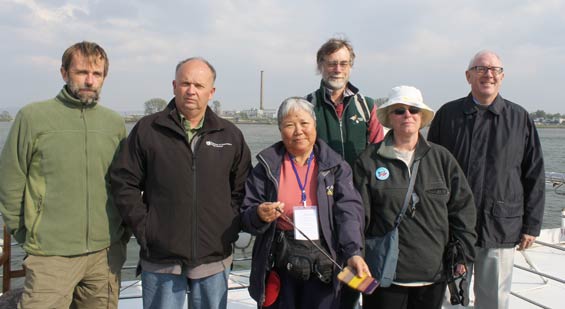
P?korokoro Miranda Naturalists Trust and DOC with NZ Ambassador on the Yalu River, North China.
L to R: Adrian Riegen – Vice Chair MN, Bruce McKinlay – DOC Techincal Advisor, Estella Lee – Councillor MNT, Keith Woodley – Manager of Miranda Shorebird Centre, Carol West – Director Terrestrial Ecosystems at DOC, HE Carl Worker – NZ Ambassador to China. © Bruce McKinlay Department of Conservation – New Zealand
- The original article: Click HERE
- Related articles:

